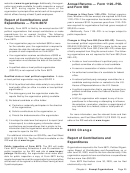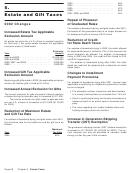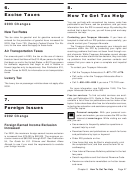Publication 553 - Highlights Of 2002 Tax Changes Page 8
ADVERTISEMENT
2003. The phaseout of the deduction and the credit will
IF your modified AGI
THEN the income limit...
is...
begin in 2004, and no deduction or credit will be allowed for
property placed in service after 2006. For more information
$150,000 or less
will not affect your credit or
about electric and clean-fuel vehicles, see chapter 12 in
exclusion.
Publication 535, Business Expenses.
$150,001 to $189,999
will reduce your credit or
exclusion.
Self-Employment Tax
$190,000 or more
will eliminate your credit or
exclusion.
The self-employment tax rate on net earnings remains the
same for 2002. This rate, 15.3%, is a total of 12.4% for
social security (old-age, survivors, and disability insur-
Credit allowed against alternative minimum tax. The
ance) and 2.9% for Medicare (hospital insurance).
provision presently in effect allowing the credit to reduce
alternative minimum tax as well as regular income tax has
Earnings limit. The maximum amount subject to the so-
been extended. This provision was originally scheduled to
cial security part for tax years beginning in 2002 has
expire in 2002.
increased to $84,900. All net earnings of at least $400 are
subject to the Medicare part.
Earned Income Credit (EIC)
New Health Insurance Credit
The following paragraphs explain the changes to the credit
for 2002. For more information, see Publication 596,
There is a new credit for health insurance premiums paid
Earned Income Credit (EIC).
by certain workers who are displaced by foreign trade or
New definition of earned income. Earned income no
who are receiving a pension from the Pension Benefit
longer includes nontaxable employee compensation. Em-
Guaranty Corporation. For more information, see Health
ployee compensation is considered earned income and is
Insurance Credit in Publication 502, Medical and Dental
used to figure the amount of your credit only if the compen-
Expenses, and Form 8885, Health Insurance Credit for
sation is taxable.
Eligible Recipients.
Elimination of modified adjusted gross income (AGI).
Tax Benefits for Adoption
You no longer need to figure modified AGI. Your credit is
figured using your AGI, not modified AGI.
Beginning in 2002, the following changes apply to the
New rules for persons with same qualifying child. If a
adoption credit and the exclusion from income of benefits
child meets the conditions to be a qualifying child of more
from your employer’s adoption assistance program. For
than one person, only one person may treat that child as a
more information, see Publication 968, Tax Benefits for
qualifying child and claim the EIC using that child. You and
Adoption.
the other person(s) can decide who will claim the credit
using that qualifying child. But if you and the other
Credit and exclusion extended. The exclusion and the
person(s) cannot agree and more than one person claims
part of the credit that were scheduled to end have been
the credit using the same child, the child can be treated as
extended.
a qualifying child only by:
Dollar limit increased. In general, the maximum credit
1) The parent, if only one of the persons is the child’s
and exclusion were increased from $5,000 ($6,000 in the
parent,
case of a child with special needs) to $10,000.
2) The parent with whom the child lived the longest
period of time during the year, if two of the persons
Expenses paid before 2002. The amount of expenses
are parents of the child and they do not file a joint
paid or incurred before 2002 that can be taken into account
return together,
is limited to the pre-2002 dollar limits. This is true even if an
adoption became final in 2002, or has not yet become final.
3) The parent with the highest AGI, if the child lived with
each parent for the same amount of time during the
Example. You adopt a child with special needs in 2002.
year and the child’s parents do not file a joint return
You paid $7,000 of qualified adoption expenses in 2001
together, or
and $3,000 of qualified adoption expenses in 2002. The
4) The person with the highest AGI, if none of the per-
maximum amount of expenses you can take into account
sons is the child’s parent.
for this adoption is $9,000 ($6,000 from 2001 plus $3,000
from 2002).
New rule for eligible foster child. An eligible foster child
has to live with you for more than half of the year. Previ-
Income limit. The income limit based on modified ad-
ously, the child must have lived with you the entire year.
justed gross income (AGI) is increased. The following table
shows whether the income limit will affect your credit or
Increased EIC on certain joint returns. A married per-
exclusion.
son filing a joint return now may get more EIC than some-
Page 8
Chapter 1 Tax Changes for Individuals
ADVERTISEMENT
0 votes
Related Articles
Related forms
Related Categories
Parent category: Financial
 1
1 2
2 3
3 4
4 5
5 6
6 7
7 8
8 9
9 10
10 11
11 12
12 13
13 14
14 15
15 16
16 17
17 18
18 19
19 20
20 21
21 22
22 23
23 24
24 25
25 26
26 27
27 28
28 29
29 30
30 31
31








